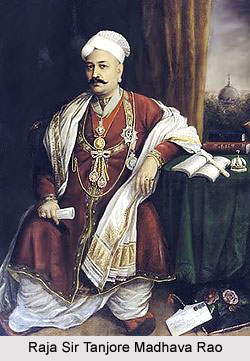 Raja Sir Tanjore Madhava Rao, also known as T. Madhava Rao or Sir Madhava Rao Thanjavurkar was the Diwan of Travancore (1857- 1872), Diwan of Indore (1873- 1875), Diwan of Baroda (1875- 1882). He was also an administrator, politician and an Indian civil servant. Tanjore Madhava Rao was the son of Ranga Rao and the nephew of T. Venkata Rao, a former Diwan of Travancore. Raja Sir Tanjore Madhava Rao served as Diwan of Travancore from the year 1857 to 1872 and focused on the advancement in education, agriculture, public health medicine, vaccination, public works and legislation. He also played a vital role in the clearance of public debts of Travancore. After he quit as the Diwan of Travancore in 1872, he went to Madras (now Chennai). He was appointed as the Diwan of Indore from the year 1873 to 1875 and later served as Diwan of Baroda from 1875 to 1882. At a later period, Madhava Rao joined politics and is considered as one of the pioneers of the Indian National Congress party. He died at the age of 63 in the year 1891 in Mylapore, Madras.
Raja Sir Tanjore Madhava Rao, also known as T. Madhava Rao or Sir Madhava Rao Thanjavurkar was the Diwan of Travancore (1857- 1872), Diwan of Indore (1873- 1875), Diwan of Baroda (1875- 1882). He was also an administrator, politician and an Indian civil servant. Tanjore Madhava Rao was the son of Ranga Rao and the nephew of T. Venkata Rao, a former Diwan of Travancore. Raja Sir Tanjore Madhava Rao served as Diwan of Travancore from the year 1857 to 1872 and focused on the advancement in education, agriculture, public health medicine, vaccination, public works and legislation. He also played a vital role in the clearance of public debts of Travancore. After he quit as the Diwan of Travancore in 1872, he went to Madras (now Chennai). He was appointed as the Diwan of Indore from the year 1873 to 1875 and later served as Diwan of Baroda from 1875 to 1882. At a later period, Madhava Rao joined politics and is considered as one of the pioneers of the Indian National Congress party. He died at the age of 63 in the year 1891 in Mylapore, Madras.
Raja Sir Tanjore Madhava Rao gained immense respect for his administrative skills. He was addressed as the Turgot of India by Henry Fawcett, a British Liberal statesman. He became a Knight Commander of the Order of the Star of India in the year 1866.
Early Life of Madhava Rao
Raja Sir Tanjore Madhava Rao was born in the year 1828 in the region of Kumbakonam, Madras Presidency, in a well known Thanjavur Marathi family. His father was the Premier of Travancore for a brief period. He had 2 elder brothers and was initially raised in Madras. He completed his education from the Government High School (Presidency College). Madhava Rao attained his Proficient`s Degree with high honours in 1846.
Career of Madhava Rao
In the year 1848, Madhava Rao was appointed as the tutor to the princes of Travancore at the suggestion of the English Resident, where he worked for 4 years as tutor. Due to his performance, he was given a job at the Revenue Department of Travancore and then became the Diwan Peishkar of the Southern Division. At the appeal of Uthram Thirunal, Raja of Travancore, Madhava Rao successfully negotiated a deal with the British administration and a result he was appointed next Diwan of Travancore in 1857.
Madhava Rao as Diwan of Travancore
During that period, the state of Travancore was suffering from poor administration, severe financial debts and was in a disorganized condition. After the death of the Maharaja in 1860, Ayilyam Thirunal, his nephew, became the new ruler. Raja Sir Tanjore Madhava Rao administration progressed under the new ruler. During his administration land tax was reduced and several cessations and petty taxes were abolished. By the year 1863, the progressive financial measures undertaken by Madhava Rao cleared the debts of the Government of Travancore. He also took various efforts to improve the state of education, agriculture, public health medicine, vaccination, public works and legislation. Madhava Rao`s bronze statue of was erected in Travancore in recognition of his services. In February 1872, he retired from this post due to some misunderstandings with the Maharaja.
Madhava Rao as Diwan of Indore
At the request of Tukojirao Holkar II of Indore, in the year 1872, the Government of India convinced Madhava Rao to become the Diwan of Indore and come out of retirement. Raja Sir Tanjore Madhava Rao served as the Diwan of Indore from the year 1873 to 1875. He initiated the drafting of the Indian Penal Code and wrote minutes on the expansion of railways in Indore.
Madhava Rao as Diwan of Baroda
Later the Indian Government appointed Madhava Rao as the Diwan-Regent of Baroda, as the ruler Malhar Rao Gaekwad was removed due to mal-administration. Madhava Rao reformed the revenue administration of Baroda. He also restructured the courts of law, libraries, schools and army. Raja Sir Tanjore Madhava Rao resigned in September 1882 due disagreements with Sayajirao Gaekwad III.
Titles of Madhava Rao
Raja Sir Tanjore Madhava Rao officially received the Title of Rajah in the year 1868.
Honours of Madhava Rao
Madhava Rao was honoured a many times; some of the prominent honours are mentioned below-
* Fellow of the Madras University (1862)
* Knight Commander of the Order of the Star of India (1866)



















